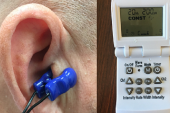ANTHEM-HFrEF Fails to Show Benefit of Vagal Nerve Stimulation Over GDMT
The randomized trial was stopped short midway through enrollment, leaving some to question what’s left on the table.

For patients who have heart failure with reduced ejection fraction (HFrEF), vagal nerve stimulation (VNS) doesn’t appear to reduce the time to cardiovascular death or heart failure hospitalization compared with guideline-directed medical therapy (GDMT)—at least not according to the ANTHEM-HFrEF trial.
However, the study was prematurely stopped for “financial” reasons at only half of its originally planned enrollment, according to the lead investigator. As such, several experts argue that no firm conclusions can truly be drawn.
Because there is autonomic dysfunction in heart failure that can be partially eliminated through VNS, some had hypothesized based on exploratory findings that this treatment could improve hard outcomes. Prior unblinded research has confirmed the safety of VNS in this population but has failed to show a true benefit.
The ANTHEM-HFrEF pivotal study, which was presented recently at the Heart Failure Society of America (HFSA) 2023 annual scientific meeting, was designed to definitively answer the question of whether VNS could work well for HFrEF patients.
“[Our goal was] to show that it had clinical benefit; that there was a clinical role for it, both on the basis of hard outcomes and also on the basis of functional measures that were important to the patient,” presenter Marvin Konstam, MD (Tufts Medical Center, Boston, MA), told TCTMD.
But after only 532 patients were enrolled—of a planned 1,000—the study sponsor LivaNova terminated the trial, a decision “not associated with either study futility, safety concerns, or device malfunction,” Konstam said during his presentation. “It was financial.”
Ultimately, ANTHEM-HFrEF showed no difference between VNS plus GDMT and GDMT alone with regard to the primary endpoint of cardiovascular death or heart failure hospitalization over about 3.5 years (HR 0.84; 95% CI 0.63-1.13).
Calling the results “incredibly disappointing and heartbreaking,” discussant Nancy Sweitzer, MD, PhD (Washington University School of Medicine, St. Louis, MO), said while the trial design was “clever,” the researchers may “have shot [themselves] in the foot.”
Specifically, she noted at HFSA, the planned interim assessments after every hundred patients enrolled meant that researchers determined futility or success based on early data. However, “maybe that gave the company a chance to say: ‘It’s not a home run at 500 patients. I think we are done.’ And that is really unfortunate,” said Sweitzer.
Enough for Further Exploration?
Of the 532 patients included in the trial, the average age was about 64 years. More than 80% were male, and more than 90% were white. Also, the vast majority were classified as having NYHA class III symptoms, and the mean LVEF was about 26%. Patients were well managed, with more than 80% on ACE inhibitors/ARBs/angiotensin receptor-neprilysin inhibitors and almost all on beta-blockers.
An analysis looking at change in Kansas City Cardiomyopathy Questionnaire (KCCQ) overall summary score from baseline to 9 months showed an advantage for VNS (13.1 vs 7.5; one-sided P < 0.001).
A supplemental endpoint added after the trial was prematurely stopped, the win ratio, showed an advantage for VNS compared with GDMT alone (1.25; one-sided P = 0.023).
“Importantly, every one of the components of the of the win ratio—cardiovascular death, heart failure hospitalizations, and KCCQ—each contributed to the favorable overall win ratio,” Konstam said.
The rate of adjudicated implant- and device-related serious adverse events (primary safety endpoint) was 3.5% at 90 days for the treatment arm, including one fatal ACS-related event at the time of the implant procedure. “It was a favorable primary safety endpoint,” Konstam said.
Acknowledging the study was a negative trial, Konstam said, “I do not agree that there was nothing in the results. First off, I think every set of results are useful and they can help us decide: is this technology that is dead or is this technology that is worth pursuing?”
Konstam said he’s uncertain whether the trial would have shown benefit had it enrolled the originally intended 1,000 patients, but argued that the holes left in the data remain intriguing. “I just cannot agree that there is nothing here, end of story, end of this modality as a possibility,” he stressed. “If I'm an investor, do I feel like I have enough here to invest in another trial? I am too close to it to really say, but I'm not particularly sure that I would.”
However, Konstam added, he will continue to work with the US Food and Drug Administration to see what might happen.
Clinical Trial Lessons
For Michelle Kittleson, MD, PhD (Cedars-Sinai, Los Angeles, CA), who commented on the study for TCTMD, the study findings speak more to clinical trial design and conduct than they do to the efficacy of VNS. “What I think this brings up more than anything, honestly, is the ethical impact on patients who commit to a study of an invasive intervention where there's certainly equipoise. [Here,] they're left not with a negative result, which we could all live with and our consciences could live with, but a ‘we don't even know result’ because of a financial concern.”
Konstam agreed that this was a hard situation for the study participants. “It's terrible what happened, okay?” he told TCTMD, adding that because of the patients who committed, “there was an ethical obligation to finish the trial.” He suggested that “when the dust settles,” this could be a chance to talk about how the academic community might prevent these situations and what to do if they occur.
As to what the study did show, Kittleson acknowledged that while the win ratio is now commonly used in clinical trials, she’s skeptical it adds anything. “For these supplemental endpoints, I just never quite know in my heart if this is playing with statistics or truly a signal of benefit,” Kittleson said.
Konstam said his team plans to continue analyzing the data they have, including the impact of the COVID-19 pandemic on the study and how often they were achieving target engagement. “The company has an obligation to provide a clinical study report to the FDA,” he said. “I have an academic investment in it, and if there is enough here to say there is a pathway to keep exploring, we want to know that there is or isn't.”
Yael L. Maxwell is Senior Medical Journalist for TCTMD and Section Editor of TCTMD's Fellows Forum. She served as the inaugural…
Read Full BioSources
Konstam MA. ANTHEM HF-rEF pivotal study: primary and supplemental endpoint results. Presented at: HFSA 2023. October 8, 2023. Cleveland, OH.
Disclosures
- The study was sponsored by LivaNova.
- Konstam reports receiving consulting fees and research support from LivaNova.
- Kittleson reports no relevant conflicts of interest.



Comments